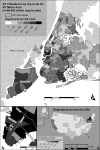An overview of 9/11 experiences and respiratory and mental health conditions among World Trade Center Health Registry enrollees
- PMID: 18785012
- PMCID: PMC2587652
- DOI: 10.1007/s11524-008-9317-4
An overview of 9/11 experiences and respiratory and mental health conditions among World Trade Center Health Registry enrollees
Abstract
To date, health effects of exposure to the September 11, 2001 disaster in New York City have been studied in specific groups, but no studies have estimated its impact across the different exposed populations. This report provides an overview of the World Trade Center Health Registry (WTCHR) enrollees, their exposures, and their respiratory and mental health outcomes 2-3 years post-9/11. Results are extrapolated to the estimated universe of people eligible to enroll in the WTCHR to determine magnitude of impact. Building occupants, persons on the street or in transit in lower Manhattan on 9/11, local residents, rescue and recovery workers/volunteers, and area school children and staff were interviewed and enrolled in the WTCHR between September 2003 and November 2004. A total of 71,437 people enrolled in the WTCHR, for 17.4% coverage of the estimated eligible exposed population (nearly 410,000); 30% were recruited from lists, and 70% were self-identified. Many reported being in the dust cloud from the collapsing WTC Towers (51%), witnessing traumatic events (70%), or sustaining an injury (13%). After 9/11, 67% of adult enrollees reported new or worsening respiratory symptoms, 3% reported newly diagnosed asthma, 16% screened positive for probable posttraumatic stress disorder (PTSD), and 8% for serious psychological distress (SPD). Newly diagnosed asthma was most common among rescue and recovery workers who worked on the debris pile (4.1%). PTSD was higher among those who reported Hispanic ethnicity (30%), household income < $25,000 (31%), or being injured (35%). Using previously published estimates of the total number of exposed people per WTCHR eligibility criteria, we estimate between 3,800 and 12,600 adults experienced newly diagnosed asthma and 34,600-70,200 adults experienced PTSD following the attacks, suggesting extensive adverse health impacts beyond the immediate deaths and injuries from the acute event.
Figures



References
-
- {'text': '', 'ref_index': 1, 'ids': [{'type': 'DOI', 'value': '10.1002/sim.2806', 'is_inner': False, 'url': 'https://doi.org/10.1002/sim.2806'}, {'type': 'PubMed', 'value': '17285683', 'is_inner': True, 'url': 'https://pubmed.ncbi.nlm.nih.gov/17285683/'}]}
- Murphy J, Brackbill RM, Thalji L, Dolan M, Pulliam P, Walker DJ. Measuring and maximizing coverage in the World Trade Center Health Registry. Stat Med. 2007;26(8):1688–1701. doi:10.1002/sim.2806. - PubMed
-
- {'text': '', 'ref_index': 1, 'ids': [{'type': 'PMC', 'value': 'PMC1241968', 'is_inner': False, 'url': 'https://pmc.ncbi.nlm.nih.gov/articles/PMC1241968/'}, {'type': 'PubMed', 'value': '15121517', 'is_inner': True, 'url': 'https://pubmed.ncbi.nlm.nih.gov/15121517/'}]}
- Landrigan PJ, Lioy PJ, Thurston G, et al. Health and environmental consequences of the world trade center disaster. Environ Health Perspect. 2004;112(6):731–739. - PMC - PubMed
-
- {'text': '', 'ref_index': 1, 'ids': [{'type': 'PMC', 'value': 'PMC1240917', 'is_inner': False, 'url': 'https://pmc.ncbi.nlm.nih.gov/articles/PMC1240917/'}, {'type': 'PubMed', 'value': '12117648', 'is_inner': True, 'url': 'https://pubmed.ncbi.nlm.nih.gov/12117648/'}]}
- Lioy PJ, Weisel CP, Millette JR. Characterization of the dust/smoke aerosol that settled east of the World Trade Center (WTC) in Lower Manhattan after the collapse of the WTC 11 September 2001. Environ Health Perspect. 2002;110(7):703–714. - PMC - PubMed
-
- {'text': '', 'ref_index': 1, 'ids': [{'type': 'PubMed', 'value': '0', 'is_inner': True, 'url': 'https://pubmed.ncbi.nlm.nih.gov/0/'}]}
- Centers for Disease Control and Prevention. Physical health status of World Trade Center rescue and recovery workers and volunteers. New York City: CDC; 2004. - PubMed
-
- {'text': '', 'ref_index': 1, 'ids': [{'type': 'DOI', 'value': '10.1164/rccm.200511-1736OC', 'is_inner': False, 'url': 'https://doi.org/10.1164/rccm.200511-1736oc'}, {'type': 'PMC', 'value': 'PMC2648115', 'is_inner': False, 'url': 'https://pmc.ncbi.nlm.nih.gov/articles/PMC2648115/'}, {'type': 'PubMed', 'value': '16645172', 'is_inner': True, 'url': 'https://pubmed.ncbi.nlm.nih.gov/16645172/'}]}
- Banauch GI, Hall C, Weiden M, Cohen H, Aldrich T, Christodoulou V. Pulmonary function after exposure to the World Trade Center collapse in the New York City Fire Department. Am J Respir Crit Care Med. 2006;174(3):312–319. doi:10.1164/rccm.200511-1736OC. - PMC - PubMed
Publication types
MeSH terms
Substances
Grants and funding
LinkOut - more resources
Full Text Sources
Medical

